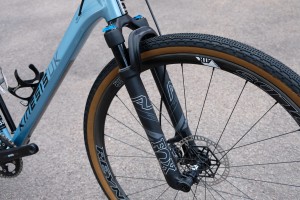
- New air spring delivers incredible suppleness and a full range of useable travel
- Revised damper gives more real-world tuning options
- Friction reducing features and clever touches keep it running smoothly for a long time
- Performance gains are marginal over more affordable forks
- Only top-spec Factory forks get all offset options
Fox's radical makeover of the 36 for 2021 has resulted in a long-travel trail fork that's more supple and sensitive which a more usable range of travel and damping. It delivers uncannily good control and support, no matter how hard you push it. In pure performance terms, it's the fork to beat in the 150-160mm category - assuming you can stomach the price.
- Five things that weren't cool - until enduro happened
- The best (and worst) mountain bike upgrades under £100
- Five ways to tell your shock needs a service
While it's always been pitched at the harder-riding end of the spectrum, the 2021 Fox 36 has been refocussed as only a 150mm or 160mm travel trail fork, with the new, burlier 38 taking over longer travel duties. It's a ground-up redesign, with everything from the chassis to the air spring and damper getting a thorough going over.
The big news is what Fox has done to counter the RockShox Lyrik's almost peerless small bump sensitivity, due in large part to a high volume negative air spring that Fox's EVOL unit simply couldn't match.
Much improved EVOL air spring
The new EVOL spring now has a larger negative air volume, achieved by extending the spring side leg of the lowers further down, giving them more space for a longer stanchion tube and therefore spring volume.
The second part of the puzzle is the way that the air volume that sits in the lower legs now has an escape path when the fork compresses, meaning it has less of an unadjustable ramp-up effect on the ending stroke of the fork. That's achieved with channels that run from the fork lowers up to where the seals sit, creating more space for the air. It also means that the lubricating oil that lives in the lower now has a path to the bushings and seals up the top for the fork.
This all means that the beginning stroke of the fork is much more supple, giving uncannily good sensitivity on small bumps, improving traction, comfort and confidence. The way the fork now holds a line over wet and slippery chatter you'd expect to have the bars dancing about in your hands and the tyre skittering about the trail is a real eye-opener. You can hit lines harder with more confidence the tyre will stick, while fatigue is greatly reduced on long, rough descents.
While the old fork needed a Herculean amount of force to bottom it out when running sensible sag - I rarely saw the last 20mm of travel even when running no volume spacers - the new fork is much happier to give up the full amount of travel while still providing superb support all the way through the mid-stroke, another positive benefit of that larger negative air volume.
I still ended up with no volume spacers in the new fork for most of the time - I'm light at 70kg and my local trails have little in the way of huge G-outs or massive drops - this does now mean the fork has much more usable travel while still being tuneable if you're heavier or a hard hucker.
The air channels in the fork lower legs also have another feature which is arguably of much less use, in the UK at least. Much like the full-on 40 downhill fork, they have air bleed valves that allow you to burp any overpressured air that's been trapped in the lowers by the seals as you ride or from changing altitudes rapidly.
I've done my best to ride as hard as possible but I've yet to have the hiss of air when I'm pressed them post-descent, but if you regularly drop thousands of metres in a single hit, they might well be of use. You can slightly cheat the system and use them to improve small bump sensitivity even further by compressing the fork and then pressing then, meaning a slight vacuum in the lower legs for even more reduced breakaway force - at the expense of a little bit of positive travel.
More usable range of adjustment on the GRIP2 damper
It's not just the air spring system that's been overhauled. While the damper is still the FIT GRIP2 unit with four-way, high and low-speed adjustment for both rebound and compression damping, there have been significant changes to how it works.
The high-speed compression circuit now gets the Variable Valve Control system that was originally only found on the high-speed rebound circuit. This means that instead of adding or removing preload on the shim stack - the thin washers of metal that provide resistance to the flow of damping oil - and thus how hard it is to move them out of the way, the new system changes the leverage the oil flow has on the shim stack when you adjust it. It's more like re-valving the damper without having to take the whole thing apart.
The overall compression damping tune also seems to be significantly lighter too. Vorsprung Suspension's excellent video on the 38 covers this with an actual dyno test, but just riding the fork and using the compression adjusters makes this obvious that the damper is much, much less forceful when it comes to compression adjustments.
I almost never added any high-speed compression (HSC) damping to the 2020 GRIP2 damper - I'm a reasonably lightweight rider but even heavy and hard riders I know never needed to use more than one or two clicks of HSC out of eight on offer, so in my opinion, the new damper offers a much more useable range of adjustment. Winding a bit of HSC on when riding trails that had big hits and bigger drops meant the fork offered more resistance to blowing through the travel, but without the harshness adjusting the old damper also added.
While there may be some talk about not having the same range of compression damping being a bad thing, I think that for most riders the new fork is a big improvement. The number of riders who do need more HSC than the new damper can provide are probably in the upper fractions of the top percentile of riders out there, so it makes more sense to me that they're the ones that would need a revalve to suit their needs - they're probably got a factory contract anyway.
Better clearance, floating axle
The chassis has also seen some fairly significant changes. For a start, the arch has been revised quite a bit to improve clearance and also optimise it for strength and reduce weight. It's also canted forwards quite a bit so that there's no chance of it hitting modern carbon fibre bikes with big fat head tubes and has mounting bolts to fit Fox's own small fender to it.
Another really neat touch is that the 15mm through-axle is a floating design that can be compensated for the slight variations in hub width that would otherwise cause the fork legs to be bent slightly out of alignment, increasing friction. You can run either a quick-release axle or slightly lighter screw-in design too.
How does it compare?
In 650b, 160mm format and with 190mm of steerer, the 2021 Fox 36 tipped the scales at 2,155g which is around 100g more than either a RockShox Lyrik or the old 36 in the same configuration. That's a little bit of extra weight, but not a huge difference in real-world terms.
The RockShox Lyrik is very much the fork that the 36 needs to surpass - and in back-to-back tests, there was very little between them. In terms of the sensitivity they offer, both are excellent, with the Fox's air spring now easily matching the superb off-the-top smoothness the Lyric's Debonair spring delivers.
I ran both forks with no volume spacers in them, but I found I was getting more of the Fox's travel while the Lyric was still fairly resistant to giving up the last little bit, even on fairly serious hits. The Fox certainly wasn't a soggy, diving mess though; it's just that the deeper stroke of the fork is easier to access when you need to use it and both fork have really excellent mid-stroke support.
Both forks have superb control, but the Fox feels like it has a slight edge here. It's uncannily good at metering out the amount of travel you need, keeping your bar height feeling level and the bike stable even when it's smashing through seriously lumpy terrain. In comparison, the Lyrik feels a little bit more 'busy' through the handlebar and I had a bit more hand tiredness at the end of my back-to-back runs. It's not night and day, but over a very long run I could imagine this would end up as a distinct advantage in the Fox's favour.
Another area where the Fox excelled was in how smooth the fork still felt after well over 100 hours of ride time, something that's likely down to all the extra lubrication the bushing and foam rings were getting due to the channels in the lowers. It's very impressive, with service intervals for lower leg oil replacement running at 125 hours of ride time versus RockShox's 50 hours.
That said, the Fox in this Kashima-coated upper leg Factory model is not cheap at £1,159. You can also opt for the non-Kashima Performance Elite, but that only saves you a mere £60 and you don't get the short 37mm offset option for 650b wheels or longer 51mm offset for 29ers. Compare that to the RockShox Lyrik Ultimate at £929 - and often available at significant discount if you look around - and that muddies the waters somewhat.
In summary
As far as I'm concerned, in pure performance terms, the Fox 36 is the best long-travel trail fork you can buy. It's a big step above the old fork when it comes to sensitivity and damping control, while the air spring improvements mean you get more usable travel, ridiculous amounts of traction and support, plus less fatigue that ever before. That performance hasn't tailed off as I've ridden it through all conditions either, which is a big positive as no one ends up servicing their fork as much as they should.
Is it better than a Lyrik? Well, in performance terms, I'd say it has the edge. It's only by a princess and the pea margin though, which makes the price premium somewhat hard to swallow. Both are superb forks and I'd be very happy to run either, but - if money is no object - the 2021 Fox 36 takes the crown.

















Add comment